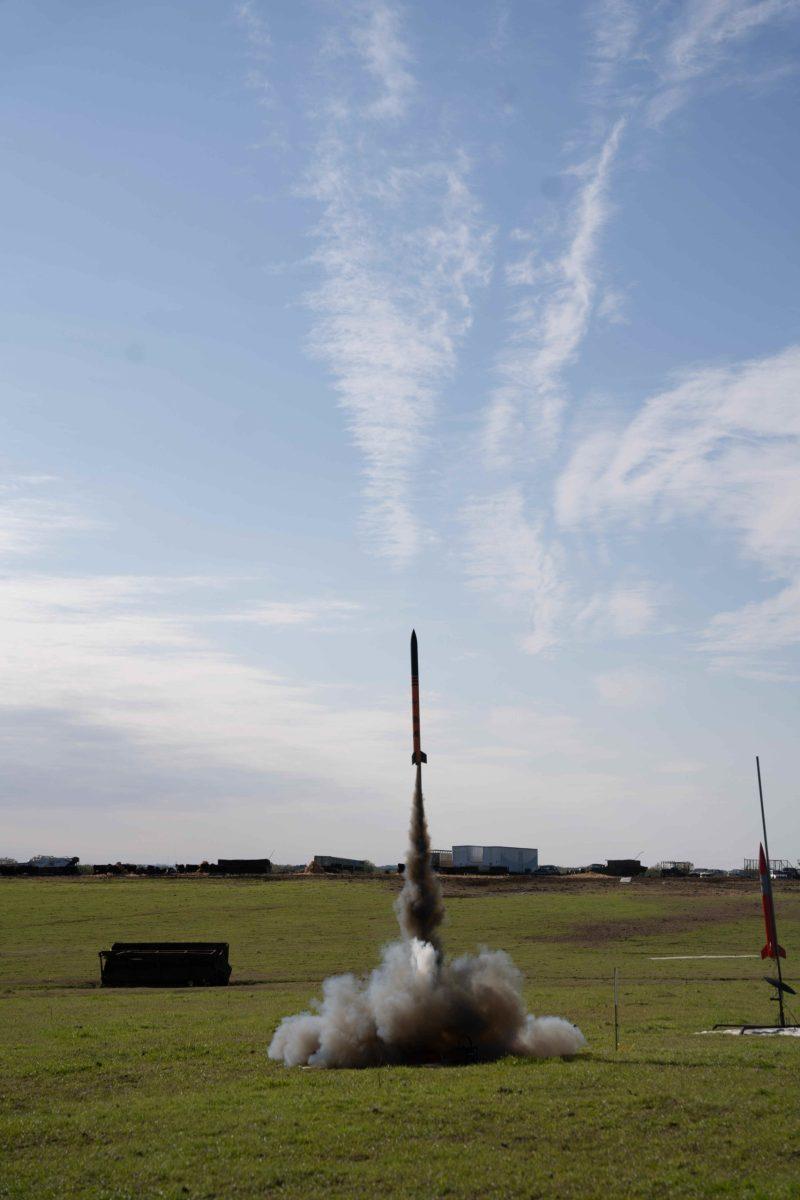The American Institute of Aeronautics and Astronautics at UTD made history on Nov. 19 when they became the first organization on campus to launch a high-powered rocket.
AIAA launched the rocket in Gunter, Texas at the Dallas Area Rocket Society, an organization dedicated to giving students an opportunity to explore their aeronautical interests. Groups from different high schools and colleges came together to launch rockets built from scratch. The organization also hosts monthly launches with three types of rockets: model rockets that are generally smaller in size, mid powered rockets that are more powerful and run on ammonium perchlorate and high-powered rockets that require a certification.
AIAA is a nationally recognized organization with many branches, one of which is at UTD. Students interested in aeronautics can explore their interests and be part of a community that supports their passion. The club makes up for UTD having removed the aerospace program many years ago. Since this is the first rocket launch, the team had to research all the foundational information and build from ground up.
The rocket was named T3R1 — or Terry —built to be 3.125 inches in diameter and 57 inches in length. Many of the components were manufactured using a laser cutter and 3D printer. The process began during the spring 2022 semester and because AIAA had never launched a rocket before, the team learned everything from scratch from resources at makerspace in SPN. Junior computer science major Alejandro Garcia was the structural lead for this project and senior mechanical engineering major Muhammad Shoaib Moosa was the lead engineer, overseeing the development of the manufacturing and design plan.
“In fact, besides the motor, all of our components were built in-house,” Moosa said. “I determined the dimensions of the rocket by doing a preliminary design on open rocket and settled on what works best for us.”
Inside the rocket was an avionics system, which monitors the rocket’s altitude during the flight and compares the rocket’s real apogee — maximum altitude — with the projection from prior simulations. The data are then used to improve future launches. Sophomore computer engineering major Emmanuel Llanes, the electronics lead, explained how Arduino Nano drove the L1 rocket’s avionics system. Arduino Nano, a multicontroller, uses a program to interact with a pressure sensor and SD card module with data for analysis.
“During the rocket’s flight, the pressure sensor continuously collects atmospheric pressure and uses this data to compute the rocket’s altitude over time,” Llanes said. “The Arduino extracts this altitude data and saves it onto an SD card that is loaded on the SD card module.”
Only one concern caught the team’s attention during the launch — the timing of the parachute deployment. The parachute was expected to deploy at apogee but instead deployed a few seconds later. They had previously performed simulations to test various aspects of the launch, one of them being the deployment, which was why this delay was a surprise.
“We realized the weight of the rocket was less than the rocket on the software that we did the simulations on, which may have caused the rocket to reach apogee faster than we anticipated,” Moosa said. “The ejection charge was set at the 10 second mark, the rocket was way into descent when the ejection charge occurred.”
The launch sets a trajectory for more launches in the upcoming months, with a high bar for UTD’s growing aerospace community. NASA holds a student launch initiative where college teams, which AIAA hopes to participate in.
“Future plans include launching an l2 rocket as a team and then participating in some competitions such as NASA student launch and the Spaceport America Cup,” Kahler said. “We will have second and third l1 launches for the teams that haven’t gotten certified on Dec. 17 and Jan. 23.”
George Sprague, the president of the Dallas Area Rocket Society, played a vital role in both the rocket building process and the launch itself. Sprague has had an interest in rockets since a young age.
“I saw a sign that said high powered rockets, Dallas Area Rocket Society,” Sprague said, “… and thought high powered — what in the world is that? Now I got to go investigate this, and I went and saw my first launch like this with high powered rockets. And my credit card hasn’t been the same ever since.”
UTD AIAA includes subgroups that work on different projects. TEKCOR is a group that works on rocketry, and other groups focus on drones or professional and technical enrichment. TEKCOR is made up of different teams that each build their own rocket and obtain rocket certifications. Each group has people working on coding payload and physically building the rocket. Senior electrical engineering major Rachel Kahler, president of AIAA, talks about how the club provides a community for students interested in aerospace.
“It’s to have sort of an aerospace presence at UTD since we don’t really have a program for it … it’s funny because there are so many people that are interested in it,” Kahler said. “I wish that we had a program for it because a lot of people are mechanical engineers, but we don’t really have an aerospace avenue for them.”
With the lack of true aerospace studies at UTD, AIAA hopes to expand their community on campus and show their interest in having an official program at the school.





